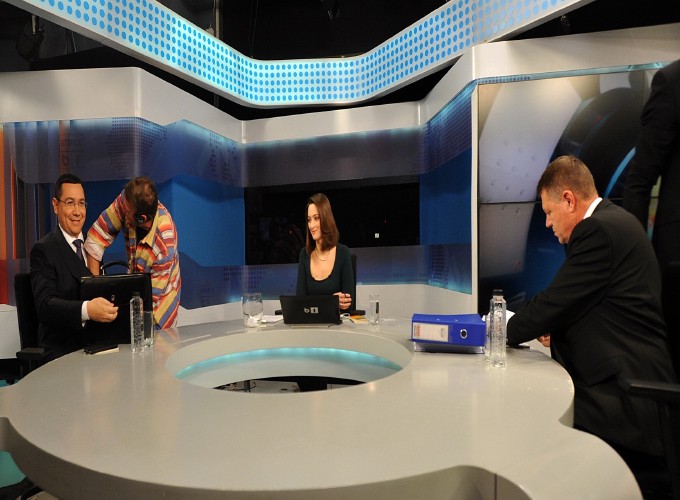Blog post published by presidential-power.com
The second round of the Romanian presidential election was held on Sunday. The incumbent prime minister, Victor Ponta, ran against Klaus Iohannis, the ethnic German mayor of Sibiu.
After the first round held on November 2, when the Social Democratic prime minister came first with a ten-point lead over the centre-right candidate, everybody expected Victor Ponta to win the runoff comfortably. After all, he topped opinion polls for months before the electoral campaign had even started. He won the first round categorically and second ballot polls have been showing him beating Klaus Iohannis by up to 55-45. Apart from Monica Macovei, who won less than 5% in the first round, no other candidate called on their supporters to vote for Iohannis. The leaders of the Hungarian minority party decided to stay neutral after the far-right came out in support for Ponta.
Overall, the electoral campaign generated little voting enthusiasm for a presidential race. Anti-corruption efforts and the conditions under which the National Anti-corruption Agency (DNA) will be able to pursue its targets in state institutions and political parties under a new head of state was one of the most hotly debated topics. However, the runoff campaign lacked a grand presidential debate aired on national television, like in 2004 and 2009. Instead, two semi-improvised debates were hosted by commercial broadcasters.
In spite of a good reputation as a successful municipal leader in Transylvania, the mayor of Sibiu could hardly claim nationwide popularity. His unusually reserved style of running a presidential campaign meant that that the masses were rarely mobilised. As a representative of both ethnic and religious minorities, few expected Klaus Iohannis to win.
Moreover, Iohannis could hardly count on local administrative support for voter mobilization. An emergency ordinance issued by the government in August 2014 gave mayors and councillors 45 days to join a different political party from the one from which they had been elected without running the risk of losing their seat as the current law stipulated. As a result, a massive migration of local administrators from the national-liberals (PNL) and the democrat-liberals (PDL), the two parties supporting Iohannis, to the social-democrats (PSD) was registered.
The result took everybody by surprise:
- Klaus Iohannis (PNL-PDL Christian-Liberal Alliance) – 54,5%
- Victor Ponta, (PSD-UNPR-PC Alliance) – 45,5%
Voter turnout reached 64%, one of the highest participation rates in Romania’s post-communist electoral history. Commentators have been raving about the impact of turnout on the election outcome. A quick look at previous presidential contests in Romania reveals why a high voter turnout was so unexpected.
Presidential elections results in Romania (1992-2014)
 Note: Election data from Election Resources on the Internet and the Central Electoral Bureau.
Note: Election data from Election Resources on the Internet and the Central Electoral Bureau.
Apart from 1990, when Ion Iliescu topped the polls with over 85% of the votes in the first round, a runoff was organized for each presidential election since 1992.
As shown in the table above, high voter turnout is not unprecedented in Romania’s presidential races. However, a similarly high level has not been reached since 1996. Moreover, the difference between the two rounds is truly exceptional: voter participation increased by 11% in the runoff. This is highly unusual in Romania, where turnout has generally been lower in the second than in the first presidential round.
As far as the results are concerned, the 2014 presidential election stands out for two reasons.
First, the gap between the front-runner and the runner-up in the first presidential round was the largest since 1992. Second, the increase in voter participation in the runoff, both within and beyond Romanian borders, hit an absolute record.
Indeed, Iohannis’ only chance in the runoff depended on the mobilization of undecided voters. But the spark that lit up the mobilization fire and gave two more million people the motivation to cast their ballots was the government’s own making and had little to do with party mobilization.
Romanians living abroad faced unprecedented difficulties in casting their ballots on 2 November. Protests broke out in front of many Romanian embassies when thousands were not allowed to vote after queueing for many hours. Romanians at home also took to the streets numerous times ahead of the runoff vote, calling on the government to increase the number of voting sections abroad.
Apart from firing the foreign minister one week after the first-round vote, PM Ponta did little to improve voting conditions abroad. He chose to find excuses elsewhere for the alleged impossibility of opening new voting sections. During the first presidential debate, Ponta even rebuffed Iohannis’ criticism about the government’s attempt to restrict voting abroad by saying that the right to vote is a mere ‘catchphrase’.
In this context, more and more anti-government rallies broke up in Bucharest and in many other cities as the runoff vote approached, calling on the government to respect the right of the Romanians abroad to cast their votes. The new foreign minister’s defiant statements on the voting day and the government’s refusal to extend the voting time after 9 p.m. fuelled even more protests. Voting participation just kept rising throughout the day.
In the end, the votes cast by about 400,000 Romanians expatriates may not have tipped the scales this time around as in 2009. But they did much more than that by generating an incredible level of solidarity of Romanians abroad and at home, as a reaction to the government’s apparent attempt to limit the full exercise of a basic democratic right. For example, the Hungarian minority participated in greater numbers in the runoff than in the first round, when they could choose between two Hungarian candidates, and overwhelmingly voted for Iohannis despite their leaders’ self-proclaimed neutrality. Ironically, many have noticed how Victor Ponta’s nationalistic campaign message – “The President Who Unites” – had the perverse effect of bringing together Romanians across borders against the concentration of power in the hands of a single political party.
What next?
On the right, Klaus Iohannis’ imminent resignation as leader of the National Liberal Party (PNL) will soon raise a succession question. He is unlikely to tip a successor, given the short period of time he has spent as a party leader. The new National Liberal Party is the result of the merger between the PNL and the PDL, which was decided in July 2014. The two parties run the presidential campaign under the Christian-Liberal Alliance formula as there had not been enough time to register the new party. The internal elections scheduled for 1 January 2017 will now have to be called earlier, stirring up old leadership rivalries within the two parties.
On the left, many social-democrats are asking for an extraordinary congress to be called and some would even like to see PM Ponta and his cabinet step down. Thus, the reorganization of the strongest Romanian party after letting the presidency slip through their fingers for the third time in a row looks imminent.
Finally, given the impact of civic activism on the election outcome, this year’s presidential race may trigger the formation of new grassroots political organisations. Monica Macovei, who ran in the first round as an independent candidate and capitalised on the success of the anti-corruption institutions she helped establish, announced the setting-up of a new political party. Her ability to obtain about 5% of the votes as an independent was put down to the active campaign run by volunteers on social media.
Klaus Iohannis will formally take over the presidency from Traian Băsescu on 22 December. The cohabitation between a centre-right president and the centre-left prime minister that started in May 2012 is bound to continue, unless a new majority is formed in the parliament or early elections are called before 2016.
In this context, many will be interested to see how the new head of state will approach the presidential role, especially since President Băsescu has often been criticized for a high level of activism. Apart from playing an important role in foreign affairs and defence, the Romanian head of state appoints the prime minister; may refuse once the appointment of an individual minister; can return bills to the parliament and/or ask the Constitutional Court to verify their legality once before signing them into law; appoints three of the nine Constitutional Court judges; and can call a referendum on matters of national importance.


